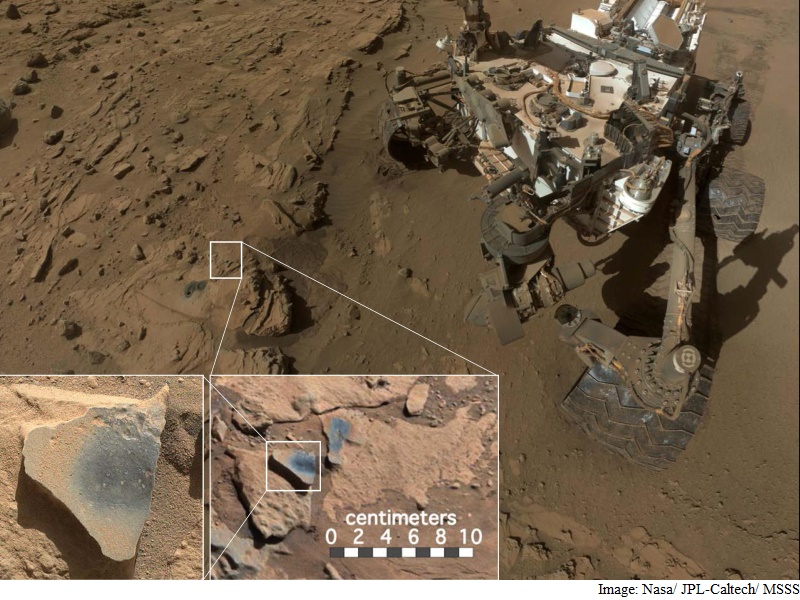- Home
- Science
- Science News
- Presence of Manganese Oxide Indicates Mars Was Once Earth Like: Study
Presence of Manganese Oxide Indicates Mars Was Once Earth-Like: Study

The discovery tells that the Red Planet was once more Earth-like than previously believed.
The hint adds to other Curiosity findings - such as evidence of ancient lakes - revealing how Earth-like our neighbouring planet once was.
"The only ways on Earth that we know how to make these manganese materials involve atmospheric oxygen or microbes," said Nina Lanza, planetary scientist at Los Alamos National Laboratory and lead author on the study.
"Now we're seeing manganese-oxides on Mars and wondering how the heck these could have formed," she added in a paper appared in the journal Geophysical Research Letters.
To reach this conclusion, Lanza used the Los Alamos-developed ChemCam instrument that sits atop Curiosity to "zap" rocks on Mars and analysed their chemical make-up.
In less than four years since landing on Mars, ChemCam has analysed roughly 1,500 rock and soil samples.
"These high-manganese materials can't form without lots of liquid water and strongly oxidizing conditions," said Lanza.
"Here on Earth, we had lots of water but no widespread deposits of manganese oxides until after the oxygen levels in our atmosphere rose due to photosynthesizing microbes," the author noted.
One potential way that oxygen could have gotten into the Martian atmosphere is from the breakdown of water when Mars was losing its magnetic field.
"It's thought that at this time in Mars' history, water was much more abundant," said Lanza.
The next step is for scientists to better understand the signatures of non-biogenic versus biogenic manganese, which is directly produced by microbes.
If it's possible to distinguish between manganese oxides produced by life and those produced in a non-biological setting, that knowledge can be directly applied to Martian manganese observations to better understand their origin.
For the latest tech news and reviews, follow Gadgets 360 on X, Facebook, WhatsApp, Threads and Google News. For the latest videos on gadgets and tech, subscribe to our YouTube channel. If you want to know everything about top influencers, follow our in-house Who'sThat360 on Instagram and YouTube.
Related Stories
- AI
- iPhone 16 Leaks
- Apple Vision Pro
- Oneplus 12
- iPhone 14
- Apple iPhone 15
- OnePlus Nord CE 3 Lite 5G
- iPhone 13
- Xiaomi 14 Pro
- Oppo Find N3
- Tecno Spark Go (2023)
- Realme V30
- Best Phones Under 25000
- Samsung Galaxy S24 Series
- Cryptocurrency
- iQoo 12
- Samsung Galaxy S24 Ultra
- Giottus
- Samsung Galaxy Z Flip 5
- Apple 'Scary Fast'
- Housefull 5
- GoPro Hero 12 Black Review
- Invincible Season 2
- JioGlass
- HD Ready TV
- Laptop Under 50000
- Smartwatch Under 10000
- Latest Mobile Phones
- Compare Phones
- Realme Realme GT Neo 6
- Nokia 3210 4G
- Vivo Y18e
- Vivo Y18
- Vivo Y38 5G
- Nokia 235 4G (2024)
- Nokia 225 4G (2024)
- Nokia 215 4G (2024)
- Dell Alienware X16 R2
- Lenovo IdeaPad Pro 5i
- Apple iPad Pro 13-inch (2024) Wi-Fi
- Apple iPad Pro 13-inch (2024) Wi-Fi + Cellular
- boAt Storm Call 3
- Lava ProWatch Zn
- Samsung Samsung Neo QLED 8K Smart TV QN800D
- Samsung Neo QLED 4K Smart TV (QN90D)
- Sony PlayStation 5 Slim Digital Edition
- Sony PlayStation 5 Slim
- LG 1.5 Ton 3 Star Inverter Window AC (TW-Q18WUXA)
- Godrej 1.1 Ton 3 Star Inverter Split AC (SIC 13DTC3 WWB)
















